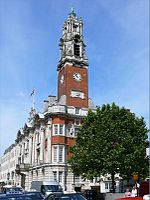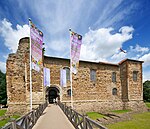Hollytrees Museum is a free to visit, publicly owned museum in the centre of Colchester and close to Colchester Castle. It is situated in an eighteenth-century house ("Hollytrees"), which was used as a private residence until 1929, when it became a museum.The first house on the site, known as "Symnells" after its owner, was later bought by the Shaw family, and passed from John Shaw to John Shaw III and John Shaw IV. When he died a minor, the house passed into chancery; his mother Jane Lessingham bought it but soon died. The modern house was constructed in for Elizabeth Cornelisen, who had bought the site from Lessingham's executors and promptly tore down the existing structure in poor condition. Construction commenced on 10 May 1718 at a cost of £630 plus brickwork and tiling; the total refurbishment was estimated to have cost £2,000. She died soon after, bequeathing the house to her niece, Sarah Creffeild (née Webster), who left it to her second husband Charles Gray. It was, at that time, known as "Esqr Creffield's [sic]". Possession of the house reverted to the Creffeilds; through Thamer Creffeild to James Round, who left to his brother Charles, who left it to his son Charles Gray Round, who left to it to his nephew James Round. The Rounds finally sold it to the Corporation of Colchester in 1922, a purchase paid for privately by Viscount Cowdray and his wife. It became a museum in 1929.The house is known as Hollytrees after two holly trees planted in the grounds by Charles Gray in 1729 and is now a free to visit museum serving the centre of Colchester and specialising in local history. It is a grade I listed building.












